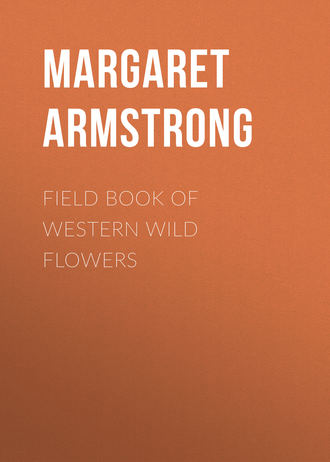 полная версия
полная версияField Book of Western Wild Flowers

Yellow Mountain Violet – V. venosa.
Canada Violet – Viola Canadensis.
Pale Mountain Violet – V. adunca var. glabra.
Blue violet
Vìola adúnca var. lóngipes
Blue, purple
Spring
Cal., Oreg.
A pretty plant, two to four inches high, with slightly hairy leaves and flowers nearly an inch long, with bright purplish-blue or violet petals, more or less veined with purple, the side petals hairy at base inside. This grows near the coast.
Johnny Jump-up, Yellow Pansy
Vìola pedunculàta
Yellow
Spring
California
Charming flowers, often growing in quantities on open hillsides. The leafy stems are from two to six inches high, the leaves rather dark green and the scentless flowers, about an inch across, have bright golden petals, with some purple lines at the base of the three lower ones, the spur and upper petals tinged with brownish-purple on the outside, the two side petals hairy at base inside, and the stigma hairy. The Spanish-Californian name is Gallito. There is no technical difference between Pansies and Violets.
LOASA FAMILY. Loasaceae
Not a very large family, all but one natives of America; herbs, armed with hooked, stinging or sticky hairs; without stipules; the flowers perfect, with five sepals and five to ten petals; the stamens numerous, with threadlike filaments, the outer ones sometimes petal-like, inserted with the petals on the throat of the calyx and usually arranged in clusters opposite the petals; the ovary inferior, with a threadlike style; the capsule crowned with the calyx-lobes.
There are many kinds of Mentzelia, all western, often with white shining stems and alternate leaves; the calyx cylindrical or top-shaped, with five lobes; the petals five or ten; the styles three, somewhat united. The barbed hairs which clothe the stems and leaves make the plant stick to whatever it touches, probably helping to distribute the seeds, hence the common name Stick-leaf.
Blazing Star
Mentzèlia laevicàulis
Yellow
Summer, autumn
West, except Wash. and Ariz.
A stout, branching biennial, two to over three feet tall, with shining white stems, almost smooth, long, rather narrow, wavy-toothed leaves and enormous flowers, in clusters of two or three at the ends of the branches and opening only in bright sunlight. They are from three to five inches across, with five, broad, light yellow petals and quantities of very long stamens, making a beautiful center. Five of the stamens have broadened filaments, resembling narrow petals, the style is three-cleft, and the capsule is oblong, containing many flat, winged seeds. These plants usually grow in dry stream-beds and are not rare, but through various accidents I have never been able to secure a drawing of either this or the next.

Blue Violet – V. adunca var. longipes.
Johnny Jump-up – Viola pedunculata.
Evening Star
Mentzèlia Líndleyi
Yellow
Summer
California
A more slender plant than the last, with magnificent flowers, two and a half inches across, which open in the evening and remain open during the following morning. They have five, broad petals, with pointed tips, bright golden-yellow, colored with vermilion at the base, and handsome yellow centers. The filaments are very slender, some of the outer ones slightly broadened at base, and the style is not cleft. This grows in the mountains. There is a drawing of it in Miss Parsons's Wild Flowers of California. It is called Buena Mujer, or Good Woman, by the Spanish Californians, because the leaves stick so tightly to one.
Mentzèlia multiflòra
Yellow
Spring
Southwest, Utah, etc.
An odd-looking plant, with very pale, straggling stems and thickish leaves, a pretty shade of pale green, all exceedingly disagreeable to touch. The buds are tipped with salmon-color and the flowers are an inch and a half to two inches across, with a long green calyx-tube with buff lobes, ten petals, bright yellow inside and pale buff outside, and pretty, fuzzy, yellow centers. They open in the evening, about five o'clock, and the plant would be pretty, in spite of its harsh foliage, if more of the flowers were out at one time. This is common along roadsides in the Southwest and in New Mexico and Colorado.
Mentzèlia gracilénta
Yellow
Spring
Southwest
This has several pale greenish or pinkish stems, from a few inches to a foot and a half tall, which look smooth but are very harsh to the touch, springing from a cluster of stiff, harsh, dull-green leaves, variously lobed or toothed. The flowers are nearly an inch across, with glossy, bright yellow petals and beautiful, fuzzy, yellow centers, and are very delicate and pretty.
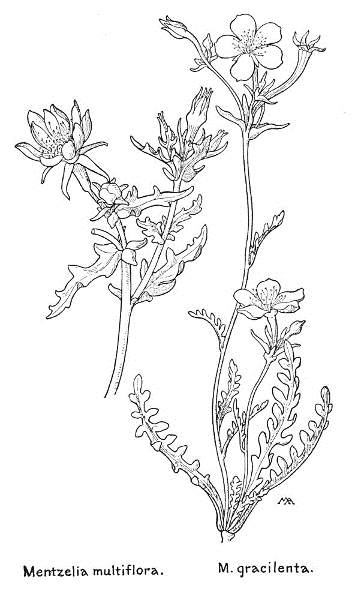
Mentzelia multiflora.
M. gracilenta.
ROCK-ROSE FAMILY. Cistaceae
A rather large family, mostly of the Mediterranean region; herbs or low shrubs; flowers regular, perfect, all the parts borne on the receptacle; sepals five, the two outer ones smaller and bract-like, or lacking; petals three to five; stamens many; ovary superior, one-celled, with a single style, or none; fruit a capsule, with several or many seeds.
There are many kinds of Helianthemum, widely distributed, perennials; leaves alternate, undivided, toothless; flowers yellow and, in most North American species, of two sorts; the earlier ones with large, yellow petals, very numerous stamens and a many-seeded pod; the later ones, small, clustered, with small petals or none, three to ten stamens, and small, few-seeded pods.
Rock-rose
Heliánthemum scopàrium
Yellow
Spring
California
A pretty plant, with many, slender stems and narrow, yellowish-green leaves, forming clumps from one to two feet high. The flowers are half an inch to three-quarters of an inch across, the buds and calyxes reddish and the petals clear yellow, the pistil greenish, with a three-lobed stigma. In favorable situations, such as Point Loma, this makes attractive little bushes, neat yet feathery, suggesting large clumps of grass, sprinkled thickly with flowers.
CACTUS FAMILY. Cactaceae
A large family, nearly all natives of America and of dry or desert places, with strange characteristics, which make them easily recognized as a whole, but many of the individuals have not yet been studied or described; fleshy plants, with thick stems, often flattened, ridged or covered with knobs, mostly without leaves, usually with spines, which generally protrude from cushions of small bristles; the flowers perfect, regular, showy, and mostly single; sepals, petals, and stamens all numerous; ovary inferior, with a long style and several stigmas; fruit usually a pulpy berry, containing many seeds.
There are many kinds of Echinocactus, round or oval plants, mostly ribbed, with bunches of spines of several kinds, arranged in straight or spiral rows; the fruits scaly, though spineless.
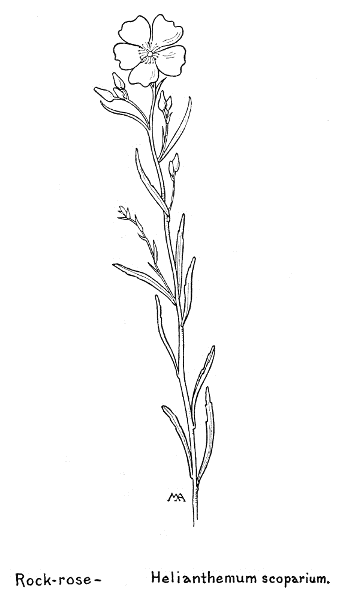
Rock-rose – Helianthemum scoparium.
Barrel Cactus, Bisnaga
Echinocáctus Wislizèni
Yellow, reddish
Summer
Southwest
A common and useful kind, the shape and often the size of a barrel, covered with spines. The Indians cut off the top of the plant and pound the pulp with a stick into a soft mass, which they squeeze with their hands, extracting a large amount of watery juice, which is wholesome and not unpalatable and has often saved lives in the desert. Indians use the spines for fish-hooks, hence a common name, Fishhook Cactus, and the celebrated cactus candy is made from it. The flowers are large.
There are many kinds of Echinocereus, oblong or cylindrical, spiny plants, generally a few inches tall, usually growing in clumps; stems ridged, or with spiny ribs; fruits spiny.
Hedgehog Cactus
Echinocèreus Polyacánthus
Red
Spring
Ariz., New Mex. Tex.
This forms a clump of several stems, each about the shape and size of a cucumber, and armed with bunches of long, stiff spines. The flowers are two or three inches long, with deep red petals, dull pink anthers, and a bright green pistil. This grows in the Grand Canyon.
There are many kinds of Opuntia, with jointed stems, cylindrical or flattened, armed with bristles, usually with spines. The fruits and fleshy joints are good for fodder, if the spines are removed, and hence there has been much inquiry into the economic value of these plants. It has been found that the spiny species are the most valuable for fodder, under extremely arid conditions, as the spines can be burned off, while the unarmed forms are subject to the attacks of so many animals that a crop cannot be secured without the protection of fences. The spines are removed either by singeing the growing plant with a torch, or the upper parts are cut off and thrown into a fire, or sometimes the plants are made into fodder by being chopped up, spines and all, in a machine. The Prickly Pears in Sicily and the Orient came from America.
Opúntia acanthocàrpa
Yellow
Spring
Southwest
From three to six feet tall, resembling Cholla, with long, cylindrical joints and whitish spines. The pretty flowers are about two inches long, with orange-yellow petals and an ivory-white pistil. The fruits are spiny and become dry when ripe. This grows in the desert around Needles.
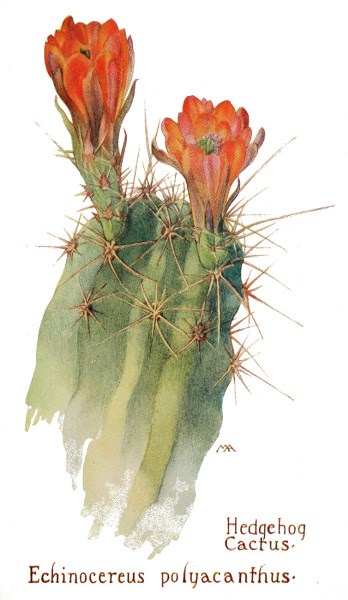
Hedgehog Cactus – Echinocereus polyacanthus.
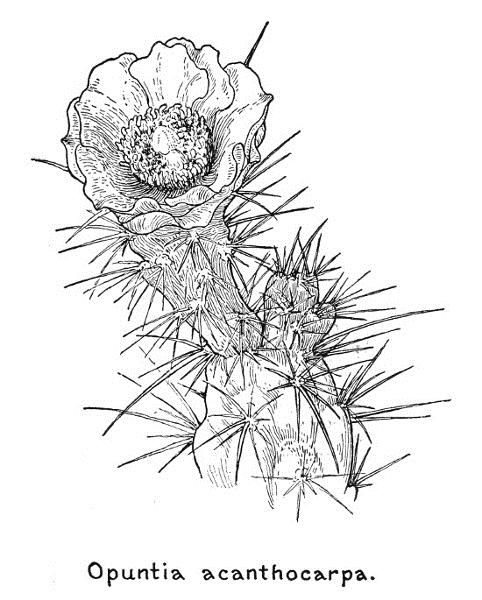
Opuntia acanthocarpa.
Cholla
Opúntia fúlgida
Red
Spring, summer
Arizona
A horrible shrub, or dwarf tree, four to six feet high, with a thick trunk and several, spreading, contorted branches, with cylindrical joints, twisting in awkward ways. The trunk and larger limbs are brownish-gray, starred with dead, dry spines, but the twigs are pale bluish-green, covered thickly with stars of pale-yellowish spines, each an inch or so long, with a barbed tip. From the numerous magenta flowers strange, yellowish, cup-shaped fruits develop, seeming to spring one out of the other in a haphazard way, hanging in long chains, awkward but rather ornamental, and remaining on the plants for several years without change, except that they grow slightly larger. The distant effect of this plant is a pale, fuzzy mass, attractive in color, giving no hint of its treacherous character – more like a wild beast than a plant! The joints suggest a very ferocious chestnut-burr and break off at a touch, thrusting their spines deeply into the flesh of the unwary passer-by, so that the Indian story, that this plant flings its darts at wayfarers from a distance, might almost as well be true, and the barbs making the extraction difficult and painful. The ground under the plants is strewn with fallen joints, which take root and propagate themselves. Small animals pile these around their holes for defense, several kinds of birds build in the thorny branches and are safe from enemies, and the fruits, being spineless and succulent, are valuable for fodder, so the Cholla is not entirely malevolent. The name is pronounced Choya. There are many similar kinds, some with very handsome rose-like flowers, others with bright scarlet fruits. They are curious and interesting inhabitants of the desert.
Prickly Pear
Opúntia basilàris
Pink
Spring
Arizona
Low plants, with no main stem, with spreading, flattened branches, the joints of which are flat disks, resembling fleshy, bluish-green leaves. These disks are half an inch to an inch thick and six inches long, more or less heart-shaped, sprouting one out of the other, at unexpected angles. The beautiful flower is about three inches across, like a tissue-paper rose, pale or very deep pink, with a whitish pistil, yellow anthers, and crimson filaments. The joints have a strong fishy smell, when cut, and are dotted with tufts of small, brown bristles, exceedingly unpleasant to get in one's fingers. This is rare and grows at the Grand Canyon. Prickly pears usually have yellow flowers and long spines.
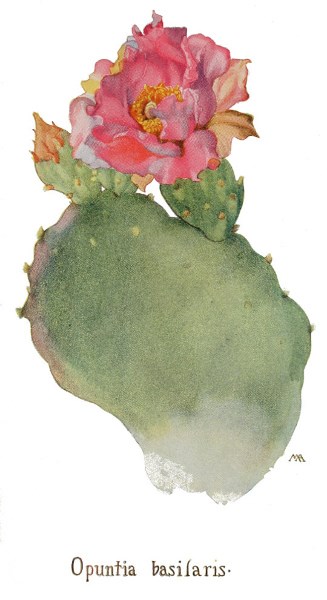
Opuntia basilaris.

Cholla (fruit).
Opuntia fulgida.
Common Prickly Pear
Opúntia
Yellow
Spring, summer
Southwest
There are fifty or more common kinds of Prickly Pear, many of them as yet undescribed and little known. They have flattened joints and yellow flowers, like the one illustrated, which is typical, often measuring three or four inches across, the petals variously tinted outside with salmon, rose, and brown.
There are many kinds of Cactus, round, cylindrical, or oval plants, covered with knobs, bearing clusters of spines, those of some species having hooked tips. They may be known by their smooth fruits, without scales or spines.
Pincushion Cactus
Cáctus Gràhami (Mamillaria)
Pink
Spring
Arizona
A quaint little plant, often no bigger than a billiard ball, with long, blackish, hooklike spines, projecting from stars of smaller spines. The flowers are pink and the berries are smooth, fleshy fingers of brightest scarlet, edible, pretty and odd. Sometimes we see one of these prickly little balls peeping from under a rock and again we find them growing in a colony, looking much like a pile of sea-urchins. This grows in the Grand Canyon, and there are similar kinds in southern California.
There are many kinds of Cereus, with cylindrical or oval stems, from a few inches to forty feet tall, not jointed, with ribs or rows of knobs, running lengthwise, and clusters of spines.
Column Cactus, Sahuaro
Cèreus gigantèus
White
Spring, summer
Arizona
These tree-like plants are wonderfully dignified and solemn in aspect, with none of the grotesque or ferocious effect so common among their relations. They grow in numbers on the mountain slopes around Tucson and are easily recognized by their size and very upright form, rearing their thick, cylindrical branches straight up in the air, to a height of thirty or forty feet. They are smooth and light green, armed with rows of spines in stars along the ridges, and ornamented during May and June with handsome, large, whitish, wax-like flowers, very perfect in form, opening in the daytime, blooming most abundantly on the sunny side of the plant and remaining open but a short time. Woodpeckers often make holes for nests in the branches, which are used afterwards by a little native owl, the smallest kind in the world, and by honey-bees, and these holes often lead to decay and to the ultimate death of the tree. The fruits, with crimson flesh and black seeds, are valued by the Papago Indians for food, and mature in enormous quantities in midsummer, but birds eat up many of the seeds and of the millions reaching the ground only a very few germinate and develop into odd, little round plants, a few inches high, often eaten by some animal before they become sufficiently prickly for protection.
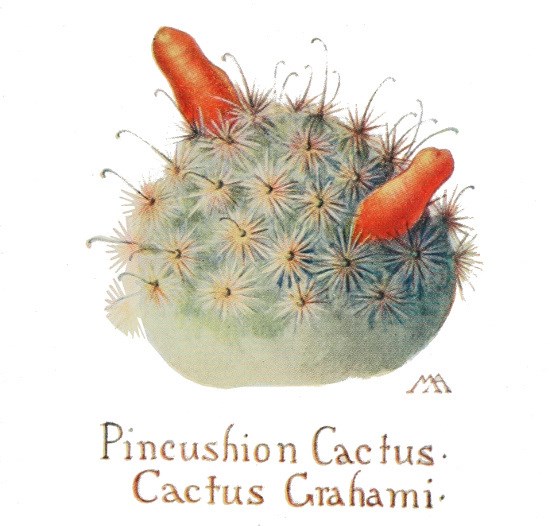
Pincushion Cactus – Cactus Grahami.
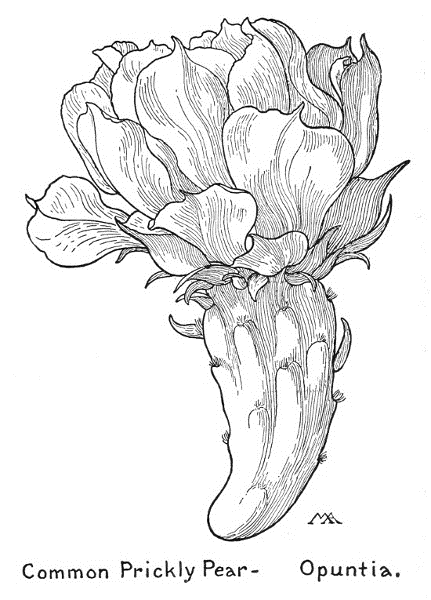
Common Prickly Pear – Opuntia.
EVENING PRIMROSE FAMILY. Onagraceae
A large family, widely distributed, most abundant in America; herbs, with no stipules; flowers usually perfect, their parts usually in fours; calyx-tube attached to the usually four-celled, inferior ovary and usually prolonged beyond it; stamens four or eight, inserted with the petals, on the throat of the calyx-tube, or on a disk; style single with a four-lobed or round-headed stigma; fruit usually a four-celled capsule, containing small seeds or a nut. The flowers are generally showy and many are cultivated.
Eulòbus Califórnicus
Yellow
Spring
Southwest
This is the only kind of Eulobus. It would be a pretty plant, if more flowers were out at one time and if they did not close so soon. The smooth, hollow, loosely-branching stem is from one to three feet tall, with a "bloom," the leaves are smooth, rather light dull-green, and the buds are erect. The flowers are about three-quarters of an inch across, with a very short calyx-tube, light-yellow petals, fading to reddish-pink, eight stamens, four of them smaller and shorter, and the light-green stigma with a round top. The slender pods are three inches long, smooth, cylindrical, and turning stiffly down, with many seeds. This grows in mountain canyons.
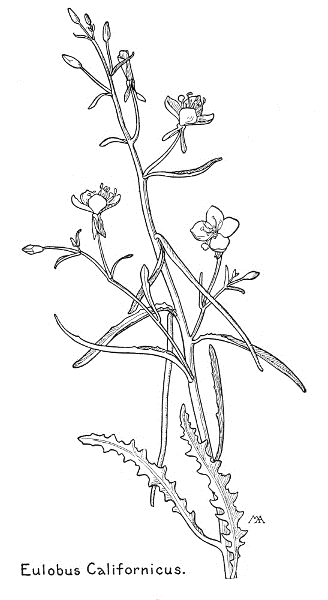
Eulobus Californicus.
There are a few kinds of Chamaenerion; perennials, often woody at base; leaves alternate; flowers in clusters, perfect, slightly irregular, white or purplish; petals four; stamens eight; style threadlike, with a four-cleft stigma; capsule long, four-sided, containing numerous seeds, tipped with a tuft of hairs. The calyx-tube is not prolonged beyond the ovary, which chiefly distinguishes this genus from Epilobium.
Fire-weed, Great Willow-herb
Chamaenèrion angustifòlium (Epilobium)
Purple, pink
Summer
Across the continent
A striking and decorative perennial, from two to six feet tall, with alternate leaves, pale on the under side, the veins making a scalloped border near the margin, the upper leaves and stems sometimes slightly downy, and the drooping buds deep reddish-pink or purple. The flowers form a fine cluster, with small bracts, each flower an inch or more across, the sepals often pink or purple and the petals bright purplish-pink; the stamens drooping, with purplish anthers; the style hairy at base, the capsule two or three inches long. This is very common, both East and West, reaching an altitude of ten thousand feet, and often growing in such quantities in the mountains as to cover large tracts with bright color. The seeds are furnished with tufts of white, silky hairs, making the plant very conspicuous when gone to seed, covering it with untidy bunches of pale down and giving a strange shaggy effect. It often flourishes in places that have been burned over, hence the name Fire-weed, and Willow-herb is from the leaves and the silky down on the seeds, suggestive of willows.
Water Willow-herb
Chamaenèrion latifòlium (Epilobium)
Magenta
Summer
Northwest
This grows in wet places; the flowers are larger and handsomer than the last, but it is not so tall. The stems are stout, reddish, and branching, from six to eighteen inches high, both stem and leaves with a "bloom," and the leaves are thickish, bluish-green on the upper side and paler yellowish-green on the under, sometimes toothed, with no veined border. The buds are deep-red and the flowers form a handsomer cluster, shorter than the last, with leafy bracts, each flower from one to over two inches across, with reddish-pink sepals, deep-red outside, and magenta petals veined with deeper color, sometimes notched, one petal longer than the others; the anthers purplish; the pistil drooping and purplish, with a smooth style. This plant is also covered with tufts of white down when gone to seed. The contrasting purples and reds of the flowers give a very vivid effect, set off by the bluish-green foliage, especially when growing among the gray rocks of moraines, watered by icy glacier streams. It reaches an altitude of ten thousand feet, growing in the East and in Europe and Asia.
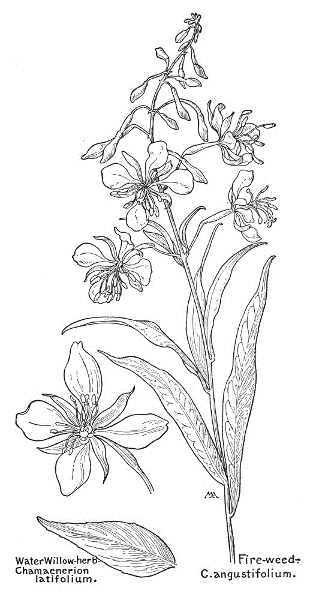
Water Willow-herb – Chamaenerion latifolium.
Fire-weed – C. angustifolium.
There are many kinds of Epilobium, differing from Chamaenerion chiefly in the calyx-tube, which is prolonged beyond the ovary.
Willow Herb
Epilòbium Franciscànum
Pink
Spring
Northwest
A perennial, not especially pretty, with a stout, reddish stem, from one to three feet tall, slightly downy above, and dull green leaves, mostly smooth and the lower ones opposite. The flowers are less than half an inch across, with bright or pale, purplish-pink petals, deeply notched and not spreading. This grows in wet spots around San Francisco.
There are several kinds of Gayophytum; differing from Epilobium in the capsule and seeds, and easily distinguished from them by the hairy buds; leaves alternate, long, narrow, and toothless; flowers small; petals four, white or pink, with very short claws; stamens, with swinging anthers, eight, four shorter and usually sterile; capsule club-shaped. The species are difficult to distinguish, because of the smallness of the flowers.
Gayophýtum eriospérmum
White
Summer
Cal., Oreg.
A delicate little plant, with smooth, purplish stems, exceedingly slender branches, dull green leaves, and pretty little flowers, an eighth of an inch to half an inch across, white, with a little yellow in the center, fading to pink. This grows in sandy soil, at rather high altitudes, in Yosemite.

Willow-herb – Epilobium Franciscanum.
Gayophytum eriospermum.
There are numerous kinds of Godetia, variable and difficult to distinguish, not yet fully understood by botanists, all western and mostly Californian, with narrow, alternate leaves and handsome flowers, which close at night. They have four petals and resemble Onagra, but the flowers are never yellow and the anthers are not swinging, but fixed to the tips of the filaments by their bases; also resembling Clarkia, but the petals are without claws. The calyx is often colored, tube more or less funnel-form, lobes turned back, or more or less united and turned to one side; stamens eight, unequal, the shorter ones opposite the petals; style threadlike; stigma with four, short lobes; capsule four-sided, or cylindrical, mostly ribbed, rather leathery, splitting open, with four valves, containing many seeds. These plants bloom in late spring, hence the pretty name, Farewell-to-Spring.
Farewell-to-Spring
Godètia defléxa

